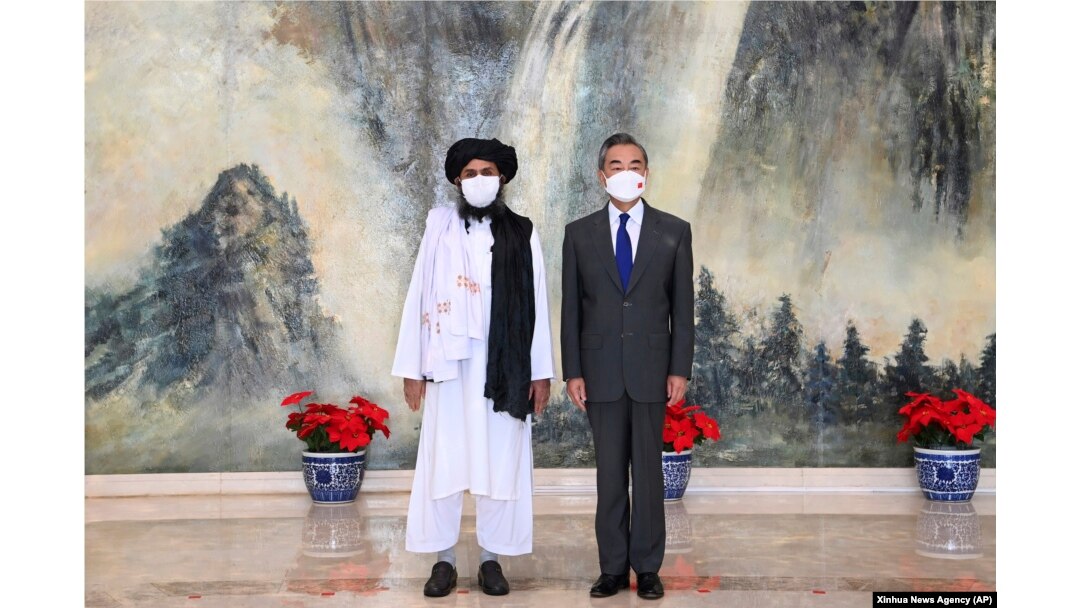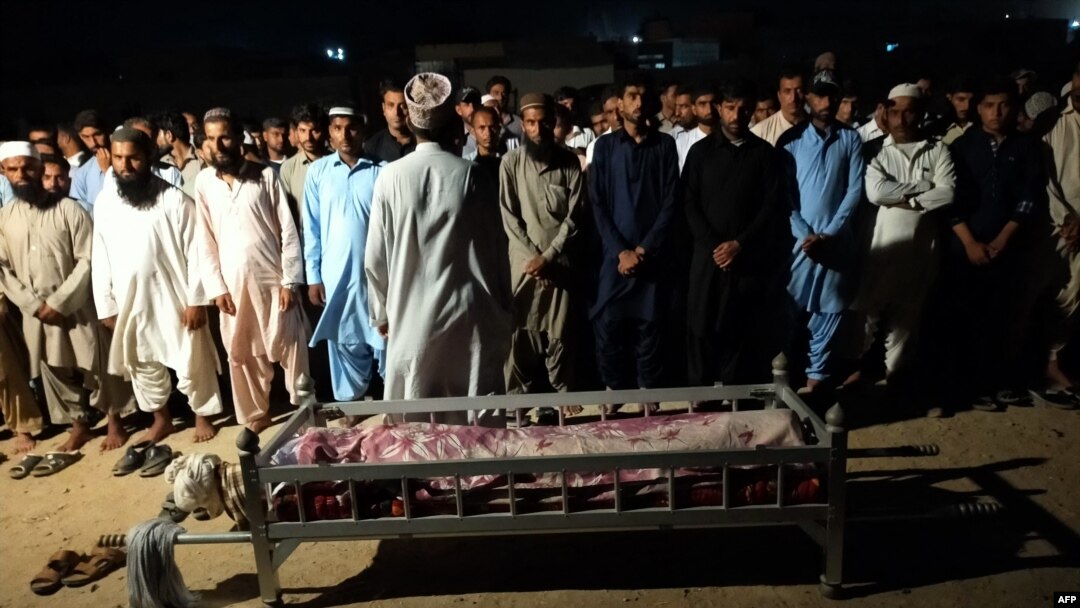Less than a week after the Taliban took Kabul and toppled the government in Afghanistan, a suicide bomber attacked a Chinese transport in the Pakistani port city of Gwadar.
While the two events were separated by more than 1,600 kilometers, they point to what many analysts say is a new era of security threats emerging for China across the wider region that could be compounded by growing instability in Afghanistan.
The August 20 attack in Gwadar was claimed by the Balochistan Liberation Army (BLA) and marked the third attack against Chinese in Pakistan in two months.
Reports vary about the scope of the most recent bombing -- the BLA claimed it killed six Chinese workers and three security guards, while Chinese and Pakistani officials say one Chinese citizen was injured and two children killed -- but the attack highlights an escalation with Chinese personnel increasingly in the crosshairs of Pakistani militants.

Taliban co-founder Mullah Abdul Ghani Baradar (left) and Chinese Foreign Minister Wang Yi pose for a photo in Tianjin on July 28.
Since the Taliban’s takeover of Afghanistan on August 15, China’s state media and officials have been triumphant in relishing the blow to Washington’s credibility after the chaotic evacuation in Kabul and the quick dissolution of the U.S.-backed government.
China has forged a pragmatic working relationship with the Taliban, with Beijing promising economic and development support to the militant group in exchange for attention to Chinese security concerns, especially monitoring and denying sanctuary to any Uyghur militant groups in Afghanistan.
“Beijing has few qualms about fostering a closer relationship with the Taliban and is ready to assert itself as the most influential outside player in an Afghanistan now all but abandoned by the United States,” Zhou Bo, a former senior colonel in China's People’s Liberation Army, wrote in a New York Times op-ed on August 20.
But despite the public confidence voiced by Beijing, many analysts see a growing worry over a wave of uncertainty taking hold in the region -- from increased terrorism to protests against Chinese projects -- that could potentially undermine China’s strategic interests in Pakistan, where the $60 China-Pakistan Economic Corridor (CPEC), a massive bundle of infrastructure and investment deals, has taken hold.
A security guard stands outside a ship at the port of Gwadar, which has been leased to a Chinese corporation by the Pakistani government.
“China is now seeing all of this as intertwined and part of a more adverse shift in the Pakistan and Afghanistan context,” Andrew Small, a fellow with the German Marshall Fund and author of The China-Pakistan Axis, told RFE/RL.
New Pushback
Central to these worries are the stepped-up attacks against Chinese in Pakistan recently.
A bus carrying Chinese workers in northern Pakistan was bombed on July 14, killing 13 people, nine of whom were Chinese, and has since been attributed to Tehrik-e Taliban Pakistan (TTP) by Pakistani authorities. They said the attack was planned inside Afghanistan.
This was followed by another attack on Chinese workers in Karachi on July 28 and, in April, China’s ambassador to Pakistan narrowly avoided a terrorist attack at a hotel in Quetta where his delegation was staying.
China has been targeted by Pakistani militants before, with the BLA launching a high-profile attack against the Chinese Consulate in Karachi in 2018. But the recent spate of incidents marks a new trend, says Abdul Basit, an expert on South Asian insurgent groups at Nanyang Technological University in Singapore.
“China’s future is in South Asia, but there is tons of volatility at the moment,” Basit told RFE/RL. “The main motivation in going after Chinese targets is that it is an effective way to cause problems for Pakistan, but the increased attacks point to a more permissive environment for groups to operate in.”
While Beijing remains fixated on the Turkestan Islamic Party (TIP) -- a Uyghur group that Beijing blames for unrest in its western Xinjiang Province and refers to it by its predecessor's name, the East Turkestan Islamic Movement (ETIM) -- groups like Al-Qaeda and the Islamic State-Khorasan (IS-K) could also pose threats to China in the future.
“The attacks are a problem, but they’re small scale when we look at the big picture,” said Basit. “The main question is how China decides to react to all of this.”
Beijing has pressed the authorities in Pakistan for improved protection for Chinese following the series of attacks that it blamed on lax security.
Taliban spokesman Zabihullah Mujahid talks with journalists during a press conference in Kabul on September 6.
China’s engagement with the Taliban has in large part been motivated by trying to prevent and contain similar threats in Afghanistan, although it remains to be seen whether the Taliban can and want to do so.
“It is a multifaceted threat posed to China from this region,” said Basit. “The security vacuum in Afghanistan following the U.S. withdrawal from Afghanistan is benefiting China, but that can only last for so long.”
Flagship Problems
Beyond increased militancy in Pakistan, the CPEC -- Beijing’s flagship project within its massive Belt and Road Initiative (BRI) -- is also facing complications and a backlash in Pakistan.
In late August, protests erupted in Gwadar against severe water and electricity shortages as protesters blocked roads in the city and burned tires. This was followed by demonstrations by local fisherman and other local workers who said their livelihoods were being threatened by Chinese trawlers illegally fishing in the nearby waters, RFE/RL's Radio Mashaal reported.
The port in Gwadar is a strategic element of the CPEC, with Islamabad leasing the port to a Chinese-backed multinational corporation for 40 years.
In July, Pakistan detained five Chinese trawlers on suspicion of illegal fishing not far from the Gwadar port. Chinese authorities denied that the detained Chinese trawlers were fishing illegally and claimed instead that they were sheltering from a storm.
In late July and early August, Chinese officials sent 26 containers of seafood and 12 containers of rice back to Pakistan, officially because they were contaminated with the coronavirus. But several Pakistani exporters told Radio Mashaal the action was a reciprocal move against Islamabad for the detention of the trawlers.
Chinese Minister of Public Security Zhao Kezhi holds an online meeting with Moeed Yusuf, national security adviser to the prime minister of Pakistan, on August 24 about security threats in the country.
Balochistan, the region where Gwadar is located, is Pakistan’s most undeveloped area and is home to a long-running violent insurgency against Islamabad led by the BLA. Gwadar is not on the national power grid and issues with a nearby dam have fueled the water shortage.
But even though China is not to blame for Balochistan's water and energy problems, its large presence in Pakistan and the region has managed to trigger unrest and breed growing anti-Chinese sentiment.
While these developments highlight growing discontent toward China on the ground in some areas, Beijing’s attention continues to be fixated on Afghanistan and the risks posed by increased militancy in the region.
“Beijing needs to be careful not to be sucked into Afghanistan and the wider region, which are viewed as a strategic trap,” said Small. “For now, China’s aim is to minimize the risks, not solve the problems.”


